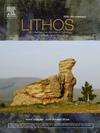Structural and metamorphic evolution of Val d'Ala eclogites (Western Alps - Lower Piemonte Zone)
IF 2.9
2区 地球科学
Q2 GEOCHEMISTRY & GEOPHYSICS
引用次数: 0
Abstract
The ophiolites of the Piemonte Zone (PZ) are remnants of the Jurassic Alpine Tethys Ocean. Their transformation into eclogites attests to the deep subduction of the oceanic crust beneath the Adria plate during Alpine convergence. The Alpine evolution in the central part of the PZ is still poorly understood, and this work focuses on the structural and thermobarometric study of Val d'Ala eclogites, one of the Lanzo valleys south of the Gran Paradiso Massif. We investigated the petro-structural evolution of eclogites, analyzed their mineral chemistry and whole-rock composition, determined the protolith age using zircon geochronology, and estimated the Alpine P-T path. The protolith of the eclogites can be traced back to basalts with an N-MORB signature. Zircon geochronology indicates a protolith 206Pb/238U age of 158.5 1.3 Ma, about 7 Myr older than the nearby Fe![]() Ti gabbros. The first tectono-metamorphic stage (D1) developed under eclogite-facies conditions reaching up 2.5 GPa and 480–500 °C, indicating a thermal gradient of 6 °C/km during the Alpine evolution. The second stage (D2) involved the exhumation of the eclogites to 1–1.5 GPa at about 460 °C, under blueschist-facies conditions, while the final stages (D3/D4) occurred under greenschist-facies conditions at about 22 °C/km. Thus, the Val d'Ala eclogites evolved and were exhumed within a cold subduction zone during the burial of the Alpine Tethys Ocean, with final exhumation occurring during the continental collision between the European and Adria plates. The comparison with the other eclogites within the PZ suggests that all these ophiolites represent different oceanic lithospheric slices sampled at various depths and possibly times, recording different structural evolutions during their burial and exhumation in the mantle wedge of the same subduction zone.
Ti gabbros. The first tectono-metamorphic stage (D1) developed under eclogite-facies conditions reaching up 2.5 GPa and 480–500 °C, indicating a thermal gradient of 6 °C/km during the Alpine evolution. The second stage (D2) involved the exhumation of the eclogites to 1–1.5 GPa at about 460 °C, under blueschist-facies conditions, while the final stages (D3/D4) occurred under greenschist-facies conditions at about 22 °C/km. Thus, the Val d'Ala eclogites evolved and were exhumed within a cold subduction zone during the burial of the Alpine Tethys Ocean, with final exhumation occurring during the continental collision between the European and Adria plates. The comparison with the other eclogites within the PZ suggests that all these ophiolites represent different oceanic lithospheric slices sampled at various depths and possibly times, recording different structural evolutions during their burial and exhumation in the mantle wedge of the same subduction zone.
Val d'Ala榴辉岩(西阿尔卑斯-下皮埃蒙特带)的构造与变质演化
皮埃蒙特带(PZ)的蛇绿岩是侏罗纪阿尔卑斯特提斯洋的残余物。它们向榴辉岩的转变证明了在阿尔卑斯辐合期间海洋地壳在亚德里亚板块下的深俯冲。PZ中部的阿尔卑斯演化仍然知之甚少,本研究的重点是大天堂地块以南兰佐山谷之一的Val d'Ala榴辉岩的结构和热气压研究。研究了榴辉岩的岩石结构演化,分析了榴辉岩的矿物化学和全岩组成,利用锆石年代学确定了原岩年龄,并估算了阿尔卑斯P-T路径。榴辉岩的原岩可以追溯到玄武岩,具有N-MORB特征。锆石年代学表明原岩206Pb/238U年龄为158.5±1.3 Ma,比附近的FeTi辉长岩年龄约7 Myr。第一期构造变质期(D1)发育于榴辉岩相条件下,温度高达2.5 GPa,温度为480 ~ 500℃,表明高寒演化的热梯度为6℃/km。第二阶段(D2)为蓝片岩相条件下的榴辉岩,温度约为460℃,温度为1-1.5 GPa,而最后阶段(D3/D4)为绿片岩相条件下的温度约为22℃/km。因此,Val d'Ala榴辉岩在阿尔卑斯特提斯洋埋藏期间在一个寒冷的俯冲带中进化并被挖掘出来,最终在欧洲板块和亚德里亚板块碰撞期间被挖掘出来。与PZ内其他榴辉岩的对比表明,这些蛇绿岩代表了在不同深度和可能时间取样的不同海洋岩石圈切片,在同一俯冲带的地幔楔中埋藏和挖掘过程中记录了不同的构造演化。
本文章由计算机程序翻译,如有差异,请以英文原文为准。
求助全文
约1分钟内获得全文
求助全文
来源期刊

Lithos
地学-地球化学与地球物理
CiteScore
6.80
自引率
11.40%
发文量
286
审稿时长
3.5 months
期刊介绍:
Lithos publishes original research papers on the petrology, geochemistry and petrogenesis of igneous and metamorphic rocks. Papers on mineralogy/mineral physics related to petrology and petrogenetic problems are also welcomed.
 求助内容:
求助内容: 应助结果提醒方式:
应助结果提醒方式:


